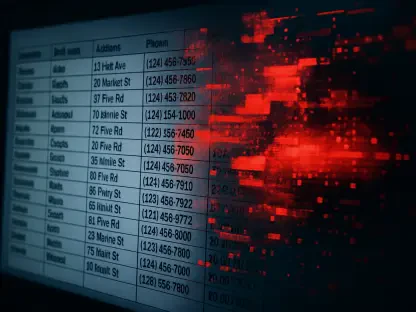Phishing attacks have become increasingly sophisticated, posing significant challenges to both users and email security systems. Among the latest techniques are email salting and homoglyph attacks, which are designed to bypass spam filters and deceive recipients. This article explores these advanced phishing methods and discusses potential strategies to combat them.
Understanding Email Salting
What is Email Salting?
Email salting is a technique where attackers insert zero-width space and zero-width non-joiner characters into the HTML code of an email. These invisible characters manipulate the displayed text to appear legitimate while the underlying code contains filler characters. This method deceives spam filters, which often rely on detecting specific words or phrases to identify spam. For example, the word “WELLS FARGO” may appear correctly to the user, but the underlying HTML code might be altered to something like “WEqcvuilLLS FAroyawdRGO.” This subtle manipulation allows the phishing email to evade detection by traditional spam filters.
The effectiveness of email salting lies in its ability to exploit the way spam filters analyze email content. By inserting zero-width characters, attackers can break up keywords that spam filters are programmed to detect. These characters are invisible to the human eye, making the email appear normal to the recipient. Spam filters typically scan for known phishing keywords and patterns. However, when these keywords are broken up by zero-width characters, the filters fail to recognize them as threats. This allows the phishing email to reach the recipient’s inbox, increasing the likelihood of a successful attack.
How Email Salting Works
The process of email salting involves strategically placing zero-width characters within the HTML code of the email, effectively breaking up the keywords that spam filters are designed to detect. This technique takes advantage of the fact that spam filters rely on specific word patterns to identify and block phishing attempts. When these patterns are disrupted by zero-width characters, the filters are unable to recognize the manipulated text as suspicious, allowing the phishing email to slip through the security net.
Additionally, email salting leverages the nature of HTML rendering, where the inserted zero-width characters remain invisible to the recipient while still disrupting the keyword patterns for spam filters. This means that the email content appears perfectly normal to the user, who is likely unaware of the hidden characters embedded within the text. As a result, the recipient may be more likely to trust the email and fall victim to the phishing attempt, highlighting the insidious nature of this sophisticated technique.
The Threat of Homoglyph Attacks
What are Homoglyph Attacks?
Homoglyph attacks involve replacing regular characters with visually similar ones from different alphabets. For instance, an attacker might replace the letter ‘o’ with a Cyrillic ‘о’. This slight deviation in Unicode encoding can trick both users and some spam filters, making it difficult to detect the phishing attempt. An example provided in the article shows “Bank of America” and “Bank оf America” (where the ‘o’ is replaced with a similar-looking character). This subtle change can easily go unnoticed by the recipient, increasing the chances of a successful phishing attack.
Homoglyph attacks exploit the visual similarity between characters from different scripts, thereby creating deceptive text that looks legitimate to the unaided eye. These attacks are particularly effective because they exploit the inherent limitations of both human perception and automated detection systems. Users may not notice the minor differences in character encoding, while spam filters may not be programmed to identify and flag these nuanced deviations, resulting in the phishing email bypassing security controls.
How Homoglyph Attacks Evade Detection
Homoglyph attacks evade detection by taking advantage of the visual resemblance between characters in different scripts, which can deceive both users and spam filters. The use of characters that look almost identical to their counterparts in other alphabets makes it challenging for automated systems to identify the discrepancies, allowing the phishing email to pass through security barriers unnoticed. This approach capitalizes on the limitations of spam filters, which may not be equipped to detect such subtle variations in character encoding.
For users, spotting homoglyph attacks requires a heightened level of vigilance and attention to detail. Even slight deviations in spelling or syntax can indicate a potential phishing attempt. However, the visual similarity of homoglyphs makes this a difficult task, as users may overlook the subtle differences and mistakenly trust the email content. This underscores the need for advanced detection tools that can analyze and flag homoglyph attacks, providing an additional layer of protection against these sophisticated phishing tactics.
Image-Based Phishing Techniques
The Use of Images in Phishing Emails
Another tactic employed by phishers is the use of images instead of text in emails. Since most legitimate businesses will not use images for vital communications like data breach warnings, recognizing this can help users identify potential phishing efforts. Images can be used to display text that would otherwise be flagged by spam filters. This method bypasses text-based detection systems, allowing the phishing email to reach the recipient’s inbox. Users should be wary of emails that rely heavily on images, especially if they contain important information.
The use of images in phishing emails presents a unique challenge for both users and security systems. Since images can convey text that might be flagged by spam filters if it were in plain text format, phishers exploit this loophole to deliver their malicious messages. Recipients of such emails may find it difficult to differentiate between legitimate and fraudulent communications, as the use of images adds a layer of complexity that can obscure the true intent of the message. Consequently, this technique requires users to be more vigilant and discerning when evaluating the content and format of received emails.
Identifying Image-Based Phishing Attempts
To identify image-based phishing attempts, users should look for inconsistencies in the email’s format. Legitimate businesses typically use text for important communications, so an email that relies solely on images should raise suspicion. Additionally, users can check the email’s source code to see if the text is embedded within an image. Spotting these inconsistencies can help users recognize potential phishing attempts and avoid falling victim to such scams.
Another useful strategy is to consider the context and origin of the email. Unexpected or unsolicited emails that rely heavily on images should be treated with caution. Additionally, users should look for other indicators of phishing, such as generic greetings, poor grammar, and requests for sensitive information. By remaining vigilant and employing these strategies, users can better protect themselves from image-based phishing attacks, enhancing their overall email security posture.
Protecting Against Advanced Phishing Techniques
User Vigilance and Awareness
Despite advancements in spam filter technology, user awareness remains the most critical line of defense against phishing attacks. Users need to be familiar with the signs of phishing attempts, scrutinize emails closely, and use available tools to verify content. For email salting, users are advised to rely on their email client’s source view feature to check the HTML code of suspicious emails. This allows them to see if the text has been salted with zero-width characters. In terms of homoglyph detection, users should scrutinize the spelling and syntax carefully and be cautious if the email domain name seems slightly off or comes from an unlikely email address.
Educating users about common phishing tactics and the importance of examining emails meticulously can significantly reduce the risk of falling victim to these scams. Training programs and awareness campaigns can help users develop the skills needed to recognize and respond appropriately to suspicious emails. By maintaining a high level of vigilance and skepticism, individuals can enhance their ability to detect and avoid phishing attempts, strengthening their overall security defenses.
Utilizing Detection Tools
Phishing attacks have grown significantly more sophisticated, creating major challenges for users and email security systems alike. Modern phishing techniques include email salting and homoglyph attacks, which cleverly bypass spam filters and deceive recipients. Email salting involves making slight alterations to email addresses or domain names, allowing phishing emails to escape detection. Homoglyph attacks, on the other hand, exploit characters that look similar to each other, fooling recipients into believing the email is from a legitimate source.
This article delves into these cutting-edge phishing strategies and offers insights into effective countermeasures. To protect against these threats, users should stay vigilant and employ multi-layered security approaches. Implementing advanced email authentication methods, educating users about phishing signs, and updating spam filters regularly are key steps. By staying informed about these evolving tactics, both individuals and organizations can improve their defenses against phishing schemes and safeguard sensitive information.









